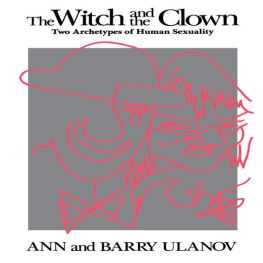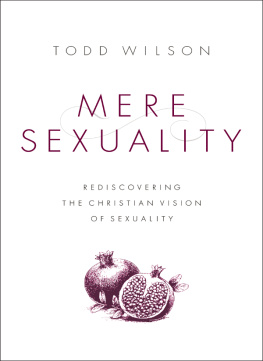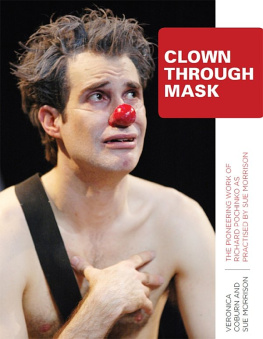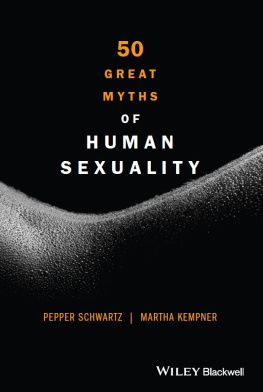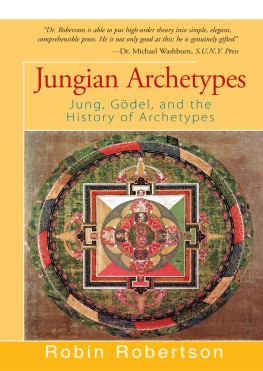Ann Belford Ulanov - The Witch and the Clown: Two Archetypes of Human Sexuality
Here you can read online Ann Belford Ulanov - The Witch and the Clown: Two Archetypes of Human Sexuality full text of the book (entire story) in english for free. Download pdf and epub, get meaning, cover and reviews about this ebook. year: 2015, publisher: Chiron Publications, genre: Romance novel. Description of the work, (preface) as well as reviews are available. Best literature library LitArk.com created for fans of good reading and offers a wide selection of genres:
Romance novel
Science fiction
Adventure
Detective
Science
History
Home and family
Prose
Art
Politics
Computer
Non-fiction
Religion
Business
Children
Humor
Choose a favorite category and find really read worthwhile books. Enjoy immersion in the world of imagination, feel the emotions of the characters or learn something new for yourself, make an fascinating discovery.
- Book:The Witch and the Clown: Two Archetypes of Human Sexuality
- Author:
- Publisher:Chiron Publications
- Genre:
- Year:2015
- Rating:5 / 5
- Favourites:Add to favourites
- Your mark:
- 100
- 1
- 2
- 3
- 4
- 5
The Witch and the Clown: Two Archetypes of Human Sexuality: summary, description and annotation
We offer to read an annotation, description, summary or preface (depends on what the author of the book "The Witch and the Clown: Two Archetypes of Human Sexuality" wrote himself). If you haven't found the necessary information about the book — write in the comments, we will try to find it.
The Witch and the Clown: Two Archetypes of Human Sexuality — read online for free the complete book (whole text) full work
Below is the text of the book, divided by pages. System saving the place of the last page read, allows you to conveniently read the book "The Witch and the Clown: Two Archetypes of Human Sexuality" online for free, without having to search again every time where you left off. Put a bookmark, and you can go to the page where you finished reading at any time.
Font size:
Interval:
Bookmark:

Second printing, 1989
Third printing, 1990
1987 by Chiron Publications. All rights reserved. No part
of this publication may be reproduced, stored in a retrieval
system, or transmitted, in any form by any means,
electronic, mechanical, photocopying, recording, or
otherwise, without the prior written permission of the
publisher, Chiron Publications, 400 Linden Avenue,
Wilmette, Illinois 60091.
Printed in the United States of America
Book design by Lauretta Akkeron
Library of Congress Cataloging in Publication Data
Ulanov, Ann Belford.
The Witch and the Clown.
Bibliography: p.
Includes index.
1. Sex role. 2. Archetype (Psychology)
3. Sex (Psychology) 4. Identity (Psychology)
I. Ulanov, Barry. II. Title.
HQ1075.U52 1987 155.3 86-21628
ISBN 0-933029-07-1
FOR ALEXANDER
Lover of Clowns and Witches
We are grateful for the interest and support of many people in the long process of bringing this book to completion, not the least of them those who responded so warmly to the lectures and workshops we conducted over a number of years on The Witch and the Clown. In gatherings brought together by Jungian groups and others, by training institutes and related organizations in San Francisco, Los Angeles, New York, Pittsburgh, Westport, Montreal, Toronto, Ottawa, Zurich, and London, people shared experiences, voiced concerns, offered insights which greatly supported and extended our understanding of the archetypes of witch and clown. We are grateful, too, for the generous support of Union Theological Seminary, in the case of Ann, and years ago of a Guggenheim Fellowship for Barry, which made possible research in areas central to this undertaking. We are thankful to Staley Hitchcock once again for making clean typewritten copy of mottled manuscript pages and to our friend, colleague, and publisher Nathan Schwartz-Salant for his graciousness and understanding.
A. U.
B. U.
We should never forget that in any psychological discussion we are not saying anything about the psyche, but that the psyche is always speaking about itself.
C. G. Jung
What is the psyche saying to us through the archetypal images of the witch and the clown? Who are these figures? Where do they appear? How do we deal with them? Why do witches turn up at all? What causes us, from childhood on, to be so fascinated by them, so eager to hear tales about them? Why does the witch persist in our imagination as a figure of archetypal dimension, more magnificent than maleficent? Why does she not retire gracefully from our central stockpile of images, now that we have come to understand that the witch-cults of the past were almost certainly the inventions of pseudo-history? How can we hold on to her as an image far more positive than negative when we think of the persecutions of women by those who believed in the monstrous fantasy of the witch-cult? Why is she not simply a quaint figure from a variously distant past, a pathetic one, even a tragic one? Why does she remain so appealing to us? Why does she still possess something that could be described as grandeur? There are many reasons.
The persistent witch of our imagination is full of secret knowledge, powerful spells, hidden ambitions, cackling revenge. What a relief she offers women trapped in dubious definitions of goodness! What permission she gives usto feel rage and envy, to accept our wishes to defeat others while triumphing ourselves! What license there is for us in her ability to turn her enemies into toads! How appealing to turn those who hurt us into slimy thingsnot to have to debate them, or out-argue them, but so effectively to silence them!
The archetypal witch arouses many reactions in us, whether she is presented in her benevolent everyday form or her threatening nightmare form, to use two traditional witch categories. We are curious about her knowledge of uncanny things. We may feel aggressive toward her, want to outsmart her, burn her in our fantasies, defeat her wily plots. We may fear her dread powers even as a mere fantasy figure, apprehensive lest she cast an evil spell on those we love. We may disapprove of her as she coldly defies all human values and lives outside human society. Yet we marvel at her too. She is a fairy-tale figure who with her white magic can bestow upon us a protean tinder box, an invisible cloak, all sorts of secret treasures. Although she often appears as a remote old crone beyond the reach of human convention, in her youthful form her seductive beauty continues to bewitch us.
The witch commands response from all ages and interests. Children have always loved to hear of her in fairy tales. They still revel in her appearances in comic-book and television versions, where she appears sometimes as a charming magician in everyday life, sometimes as a nightmarish villain. The Cat-Woman of Batman days was a combination of the witches, an ambiguous mixture of good and bad, a plotter of evil who sometimes occasioned good results. Such a figure evokes a fearful delight in young audiences.
In the womens movement one group decided to champion the witch, taking the letters of her name to identify its cause: Witchs International Terrorist Conspiracy from Hell. Their manifesto supports all the witch qualities of the female that patriarchal society proscribes. It lauds aggressive women who reject playing a supportive role to men, and who eschew feminine gentility as well, screeching and bellowing their rage rather than swallowing it or masochistically directing it against themselves.
The image of the witch that survives from the centuries of the witch hunt, especially the sixteenth and seventeenth centuries, is a projection that can well exercise an aroused feminist. A terrifying conspiracy was foisted onto actual women in many different times and places, uniting a cunning intellectuality and a maddened animality, each more diabolic than the other, and both ascribed to pacts with the Devil. As we know, that projection was used to hound and to persecute women, to outlaw them, to torture them, to kill them. So strong was the power of the witch image to summon up all the qualities that various communities, usually religious, found hateful or alluring, that ordinary scruples were easily overridden in pursuit of the witch.
It is not insignificant that the assiduous hunt of the witch-woman reached its peak in the sixteenth and seventeenth centuries. In a time of burgeoning intellectuality and the development of a philosophy of scientific investigation, persecutorial demonology achieved its greatest triumph. The persecutors were not simply ignoramuses and bigots who had achieved power. Among them were men like the philosopher of law Jean Bodin, whose Dmonomanie des sorciers of 1580 was a handbook for judges used in the trials of sorcerers. A hundred years later the English divine Joseph Glanvill wrote Saducismus Triumphatus, which pleased even so considerable a figure as the Cambridge Platonist Henry More with its analysis and condemnation of witchcraftso much so that More added material of his own to a later edition of the book.
For reasons that we shall hope to make clear in this book, women of unmistakable craft, whether of mind or of body or of both, are not easily tolerated. They are particularly objectionable when they seem to have access to those powers of mind that are sanctioned in only a very small number of personsexclusively male persons in the sixteenth and seventeenth centuries and before. When the powers are associated with subjects and positions reserved by church and society for a designated few, the affront is intolerable. Having apparently broken the sacred law intellectually, these women could be imagined to have done so in every other way as wellcould be, would be, must be. Surely they are consorts of the Devil. They must be understood to have done every foul deed that persons constrained by law or belief from doing themselves can imagine another doingand secretly wish to do themselves. Thus the fullness of the projection which resulted in witch hunts in earlier times. Thus the significance today of the question, Who and why the witch? In order to answer this question, we must focus on a symbol of forces so potent within us that they can utterly distort our perception of reality and turn us into persecutors and murderers, alive with prejudice, with sexual perversion, with blood lustat least in our imaginations.
Font size:
Interval:
Bookmark:
Similar books «The Witch and the Clown: Two Archetypes of Human Sexuality»
Look at similar books to The Witch and the Clown: Two Archetypes of Human Sexuality. We have selected literature similar in name and meaning in the hope of providing readers with more options to find new, interesting, not yet read works.
Discussion, reviews of the book The Witch and the Clown: Two Archetypes of Human Sexuality and just readers' own opinions. Leave your comments, write what you think about the work, its meaning or the main characters. Specify what exactly you liked and what you didn't like, and why you think so.

